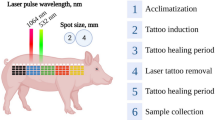Abstract
Strength of the laser–tissue interaction varies even within a single tattoo because of the inhomogeneous distribution of the tattoo pigment embedded in the skin. A monitoring system is therefore developed for simultaneous monitoring of the laser tattoo removal process based on acoustical and optical techniques. A laser-beam-deflection probe is used for measuring the acoustical signals accompanying the breakdown, and a CCD camera captures the level and the spatial distribution of the plasma radiation. Using these methods we examine the degree of excitation-pulse absorption within the pigment and the degree of the structural changes of the skin. A Nd:YAG laser with a top-hat beam profile, designed for tattoo removal, is used as the excitation source in our experiments. Special attention is given to structural changes in the skin, which depend on the applied fluence. Tattoo removal with multiple pulses is also analyzed. Experiments are made in vitro (skin phantoms) and ex vivo (marking tattoos on the pig skin). The presented results are important for the understanding and optimization of the process used in medical therapies.







Similar content being viewed by others
References
K.M. Kent, E.M. Graber, Dermatol. Surg. 38, 1 (2012)
R.R. Anderson, J.A. Parrish, Science 220, 524 (1983)
S. Choudhary, M.L. Elsaie, A. Leiva, K. Nouri, Lasers Med. Sci. 25, 619 (2010)
A. Vogel, V. Venugopalan, Chem. Rev. 103, 577 (2003)
F.G. Perez-Gutierrez, S. Camacho-Lopez, G. Aguilar, J. Biomed. Opt. 16, 115001 (2011)
J.E. Ferguson, S.M. Andrew, C.J.P. Jones, P.J. August, Br. J. Dermatol. 137, 405 (1997)
J. Možina, J. Diaci, Appl. Phys. B 105, 557 (2011)
V.K. Pustovalov, Laser Phys. 4, 612 (1994)
A. Vogel, P. Schmidt, B. Flucke, Proc. SPIE 4257, 184 (2001)
M. Jezeršek, L. Grad, T. Požar, B. Cencič, I. Bacak, J. Možina, Proc. SPIE 8092, 809214 (2011)
J. Diaci, Rev. Sci. Instrum. 63, 5306 (1992)
M. Villagran-Muniz, H. Sobral, R. Navarro-Gonzalez, Meas. Sci. Technol. 14, 614 (2003)
R. Petkovšek, P. Gregorčič, J. Možina, Meas. Sci. Technol. 18, 2972 (2007)
Z. Vižintin, M. Kažič, B. Cencič, L. Grad, D. Škrabelj, M. Lukač, Full spectrum tattoo removal laser system. Presented at IMCAS Conference, Paris, 2009
P. Gregorčič, R. Petkovšek, J. Možina, G. Močnik, Appl. Phys. A 93, 901 (2008)
M. Milanič, B. Majaron, J. Biomed. Opt. 14, 064024 (2009)
J. Diaci, J. Možina, J. Phys. IV 4, 737 (1994)
B. Cencič, L. Grad, J. Možina, M. Jezeršek, J. Biomed. Opt. 17, 047003 (2012)
J. Diaci, J. Možina, Appl. Phys. A 55, 352 (1992)
G.M. Bilmes, D.J.O. Orzi, O.E. Martinez, A. Lencina, Appl. Phys. B 82, 643 (2006)
W.M. Steen, J. Mazumder, Laser Material Processing, 4th edn. (Springer, London, 2010). Chap. 5.4.1
M. Milanič, B. Majaron, Proc. SPIE 8207, 82070G (2012)
Acknowledgements
This work was supported by the EUREKA organization under the project “Intelligent Laser Sources in Dermatology and Aesthetic Medicine—iLUMEN”.
Author information
Authors and Affiliations
Corresponding author
Rights and permissions
About this article
Cite this article
Cencič, B., Gregorčič, P., Možina, J. et al. Laser tattoo removal as an ablation process monitored by acoustical and optical methods. Appl. Phys. A 112, 65–69 (2013). https://doi.org/10.1007/s00339-012-7203-0
Received:
Published:
Issue Date:
DOI: https://doi.org/10.1007/s00339-012-7203-0




